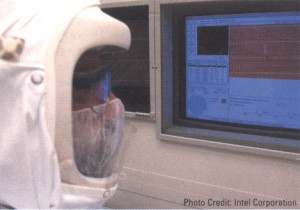
R |
IO RANCHO, N.M. – Driving along the highway from Albuquerque, N.M., to suburban Rio Rancho to the north, the first thing one notices hovering over the town is the giant corporate edifice of the Intel Corp.
Dominating the city landscape like the majestic Sandia Mountains to the east, Intel’s sprawling, 2 million-sq.-ft. (185,800-sq.-m.) campus is home to more than 5,500 permanent employees and some 5,600 contract workers.
It is not just a collection of buildings on the side of a mountain. It is a city within a city.
Gerald A. Porter, vice president of CRESA Partners in Los Angeles, says that Rio Rancho is a prime example of what he calls “the new company town.”
“At a certain scale, these semiconductor plants are creating their own environments,” says Porter, an expert on the location of high-tech manufacturers. “They are training their own workers in the community. In some cases they are importing people – not unlike what Cisco Systems has done in San Jose, Calif. They are trying to develop the live-work infrastructure that is important as these facilities get built up. Cisco, Intel and a number of the chip-fab plants are beginning to create their own company towns.”
In our cover story, we explore not only the Intel corporate strategy to undertake a $2 billion chip-fabrication expansion in Rio Rancho, but also the reasons why companies like Intel and Hewlett-Packard choose second- and third-tier markets in the Mountain West over more established cities in California.
“These large facilities, which represent huge investments of capital, are becoming pioneering locations,” Porter says. “Why are they selecting remote Western locations like Rio Rancho, N.M., Chandler, Ariz., and Colorado Springs, Colo.? In large part, it is because the municipalities themselves are doing a much better job of engineering their recruitment and creating city, county and state incentives to create jobs. The more aggressive underdogs are the ones focusing on job retention and maintaining their existing job platform to keep the local talent.”
The trade-off for companies like Intel, says Porter, is that they get to prosper in communities that don’t suffer from critical problems like “traffic congestion and power outages.” Plus, he adds, “the more remote areas often are more accommodating in allowing these facilities to be built and in not imposing as many taxes and fees.”
As companies like Intel flex their muscle and take on an ever-expanding role as corporate citizens, the communities to which they belong become more and more dependent upon those companies to act like good neighbors and generate new jobs.
The alliance doesn’t always work to perfection, as our story attests, but without a solid partnership the fortunes of both the company and the town would fade. What Intel is to Rio Rancho, Wal-Mart is to Bentonville, Ark., WorldCom is to Clinton, Miss., and Microsoft is to Redmond, Wash.
Interestingly, all of these company towns have this one simple ingredient in common: a corporate partner led by a risk-taking visionary.
People in the business world normally credit Andy Grove, Sam Walton, Bernie Ebbers and Bill Gates with building companies, not cities, but in essence they have built both.
For this reason and others, the editors of Site Selection have chosen the Intel plant expansion in Rio Rancho as one of the top 10 economic development deals of 2000 (see story).
But that’s not the only success story to tell in New Mexico. Because of its banner year in generating new corporate investment, Albuquerque Economic Development Inc. has been named one of the top 10 economic development groups of 2000 (see story). We also report on those ED groups that launched innovative development programs and services last year, as well as the top “breakthrough deals” of 2000.
Some of the names of the winning ED groups and the deals they signed last year may surprise you. We hope they do.
The top groups and top deals reports are more than an interesting collection of stories in a magazine, however. They are a testament to the ingenuity and industriousness of hundreds of professionals in the fields of corporate real estate and economic development.
Without them, there would be no company towns.

